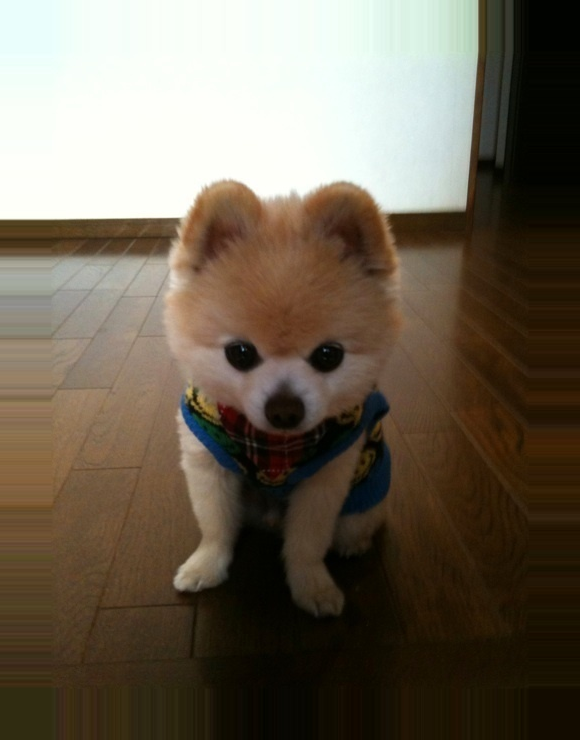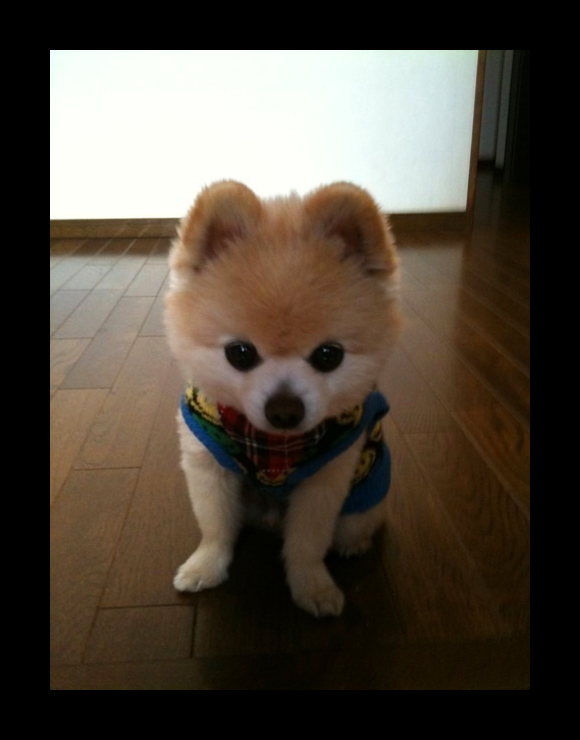Javascript图像处理——虚拟边缘
2012-12-27 09:58 Justany_WhiteSnow 阅读(3618) 评论(4) 编辑 收藏 举报前言
上一篇文章,我们来给矩阵添加一些常用方法,这篇文章将讲解图像的虚拟边缘。
虚拟边缘
虚拟边缘就是按照一定映射关系,给图像添加边缘。
那么虚拟边缘有什么用呢?比如可以很容易做一个倒影的效果:

当然这只是附带效果了,虚拟边缘主要用在图像卷积运算(例如平滑操作)时候,由于卷积运算的特点,需要将图片扩大才能对边角进行卷积运算,这时候就需要对图片进行预处理,添加虚拟边缘。
说白了,就是在一些图片处理前进行预处理。
边缘类型
这里参考OpenCV相关文档的边缘描述:
/* Various border types, image boundaries are denoted with '|' * BORDER_REPLICATE: aaaaaa|abcdefgh|hhhhhhh * BORDER_REFLECT: fedcba|abcdefgh|hgfedcb * BORDER_REFLECT_101: gfedcb|abcdefgh|gfedcba * BORDER_WRAP: cdefgh|abcdefgh|abcdefg * BORDER_CONSTANT: iiiiii|abcdefgh|iiiiiii with some specified 'i' */举个例子BODER_REFLECT就是对于某一行或某一列像素点:
abcdefgh
其左的虚拟边缘对应为fedcba,右边对应为hgfedcb,也就是反射映射。上图就是通过对图片底部进行添加BORDER_REFLECT类型的虚拟边缘得到的。
而BORDER_CONSTANT则是所有边缘都是固定值i。
实现
因为BORDER_CONSTANT比较特殊,所以和其他类型分开处理。
function copyMakeBorder(__src, __top, __left, __bottom, __right, __borderType, __value){
if(__src.type != "CV_RGBA"){
console.error("不支持类型!");
}
if(__borderType === CV_BORDER_CONSTANT){
return copyMakeConstBorder_8U(__src, __top, __left, __bottom, __right, __value);
}else{
return copyMakeBorder_8U(__src, __top, __left, __bottom, __right, __borderType);
}
};
这个函数接受一个输入矩阵src,每个方向要添加的像素大小top,left,bottom,right,边缘的类型borderType,还有一个数组value,即如果是常数边缘时候添加的常数值。
然后我们引入一个边缘的映射关系函数borderInterpolate。
function borderInterpolate(__p, __len, __borderType){
if(__p < 0 || __p >= __len){
switch(__borderType){
case CV_BORDER_REPLICATE:
__p = __p < 0 ? 0 : __len - 1;
break;
case CV_BORDER_REFLECT:
case CV_BORDER_REFLECT_101:
var delta = __borderType == CV_BORDER_REFLECT_101;
if(__len == 1)
return 0;
do{
if(__p < 0)
__p = -__p - 1 + delta;
else
__p = __len - 1 - (__p - __len) - delta;
}while(__p < 0 || __p >= __len)
break;
case CV_BORDER_WRAP:
if(__p < 0)
__p -= (((__p - __len + 1) / __len) | 0) * __len;
if(__p >= __len)
__p %= __len;
break;
case CV_BORDER_CONSTANT:
__p = -1;
default:
error(arguments.callee, UNSPPORT_BORDER_TYPE/* {line} */);
}
}
return __p;
};
这个函数的意义是对于原长度为len的某一行或者某一列的虚拟像素点p(p一般是负数或者大于或等于该行原长度的数,负数则表示该行左边的像素点,大于或等于原长度则表示是右边的像素点),映射成这一行的哪一个像素点。我们拿CV_BORDER_REPLICATE分析一下,其表达式是:
__p = __p < 0 ? 0 : __len - 1;
也就是说p为负数时(也就是左边)的时候映射为0,否则映射成len - 1。
然后我们来实现copyMakeBorder_8U函数:
function copyMakeBorder_8U(__src, __top, __left, __bottom, __right, __borderType){
var i, j;
var width = __src.col,
height = __src.row;
var top = __top,
left = __left || __top,
right = __right || left,
bottom = __bottom || top,
dstWidth = width + left + right,
dstHeight = height + top + bottom,
borderType = borderType || CV_BORDER_REFLECT;
var buffer = new ArrayBuffer(dstHeight * dstWidth * 4),
tab = new Uint32Array(left + right);
for(i = 0; i < left; i++){
tab[i] = borderInterpolate(i - left, width, __borderType);
}
for(i = 0; i < right; i++){
tab[i + left] = borderInterpolate(width + i, width, __borderType);
}
var tempArray, data;
for(i = 0; i < height; i++){
tempArray = new Uint32Array(buffer, (i + top) * dstWidth * 4, dstWidth);
data = new Uint32Array(__src.buffer, i * width * 4, width);
for(j = 0; j < left; j++)
tempArray[j] = data[tab[j]];
for(j = 0; j < right; j++)
tempArray[j + width + left] = data[tab[j + left]];
tempArray.set(data, left);
}
var allArray = new Uint32Array(buffer);
for(i = 0; i < top; i++){
j = borderInterpolate(i - top, height, __borderType);
tempArray = new Uint32Array(buffer, i * dstWidth * 4, dstWidth);
tempArray.set(allArray.subarray((j + top) * dstWidth, (j + top + 1) * dstWidth));
}
for(i = 0; i < bottom; i++){
j = borderInterpolate(i + height, height, __borderType);
tempArray = new Uint32Array(buffer, (i + top + height) * dstWidth * 4, dstWidth);
tempArray.set(allArray.subarray((j + top) * dstWidth, (j + top + 1) * dstWidth));
}
return new Mat(dstHeight, dstWidth, new Uint8ClampedArray(buffer));
}
这里需要解释下,边缘的复制顺序是:先对每行的左右进行扩展,然后在此基础上进行上下扩展,如图所示。
然后我们根据ArrayBuffer的性质,将数据转成无符号32位整数来操作,这样每个操作单位就对应了每个像素点了。什么意思?
比如对于某个像素点:RGBA,由于某个通道是用无符号8为整数来存储的,所以实际上一个像素点则对应了32位的存储大小,由于ArrayBuffer的性质,可以将数据转成任意类型来处理,这样我们就可以通过转成Uint32Array类型,将数据变成每个像素点的数据数组。
那么copyMakeConstBorder_8U就比较容易实现了:
function copyMakeConstBorder_8U(__src, __top, __left, __bottom, __right, __value){
var i, j;
var width = __src.col,
height = __src.row;
var top = __top,
left = __left || __top,
right = __right || left,
bottom = __bottom || top,
dstWidth = width + left + right,
dstHeight = height + top + bottom,
value = __value || [0, 0, 0, 255];
var constBuf = new ArrayBuffer(dstWidth * 4),
constArray = new Uint8ClampedArray(constBuf);
buffer = new ArrayBuffer(dstHeight * dstWidth * 4);
for(i = 0; i < dstWidth; i++){
for( j = 0; j < 4; j++){
constArray[i * 4 + j] = value[j];
}
}
constArray = new Uint32Array(constBuf);
var tempArray;
for(i = 0; i < height; i++){
tempArray = new Uint32Array(buffer, (i + top) * dstWidth * 4, left);
tempArray.set(constArray.subarray(0, left));
tempArray = new Uint32Array(buffer, ((i + top + 1) * dstWidth - right) * 4, right);
tempArray.set(constArray.subarray(0, right));
tempArray = new Uint32Array(buffer, ((i + top) * dstWidth + left) * 4, width);
tempArray.set(new Uint32Array(__src.buffer, i * width * 4, width));
}
for(i = 0; i < top; i++){
tempArray = new Uint32Array(buffer, i * dstWidth * 4, dstWidth);
tempArray.set(constArray);
}
for(i = 0; i < bottom; i++){
tempArray = new Uint32Array(buffer, (i + top + height) * dstWidth * 4, dstWidth);
tempArray.set(constArray);
}
return new Mat(dstHeight, dstWidth, new Uint8ClampedArray(buffer));
}
效果图
CV_BORDER_REPLICATE

CV_BORDER_REFLECT

CV_BORDER_WRAP

CV_BORDER_CONSTANT

更多的例子
系列目录
参考资料
在OpenCV中图像边界扩展 copyMakeBorder 的实现 . viewcode . 2012-12-13 09:28





【推荐】国内首个AI IDE,深度理解中文开发场景,立即下载体验Trae
【推荐】编程新体验,更懂你的AI,立即体验豆包MarsCode编程助手
【推荐】抖音旗下AI助手豆包,你的智能百科全书,全免费不限次数
【推荐】轻量又高性能的 SSH 工具 IShell:AI 加持,快人一步
· Linux系列:如何用 C#调用 C方法造成内存泄露
· AI与.NET技术实操系列(二):开始使用ML.NET
· 记一次.NET内存居高不下排查解决与启示
· 探究高空视频全景AR技术的实现原理
· 理解Rust引用及其生命周期标识(上)
· DeepSeek 开源周回顾「GitHub 热点速览」
· 物流快递公司核心技术能力-地址解析分单基础技术分享
· .NET 10首个预览版发布:重大改进与新特性概览!
· AI与.NET技术实操系列(二):开始使用ML.NET
· 单线程的Redis速度为什么快?